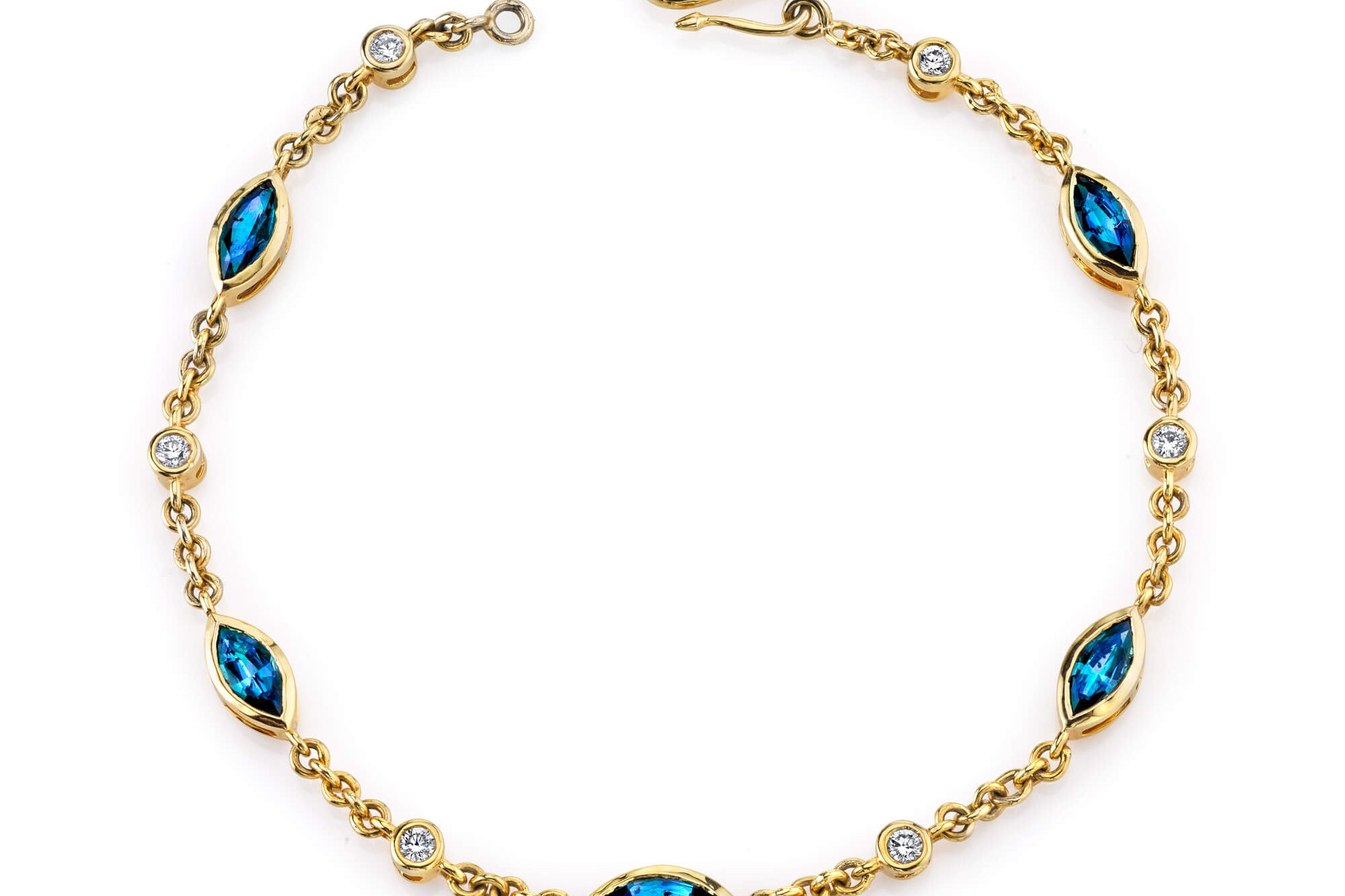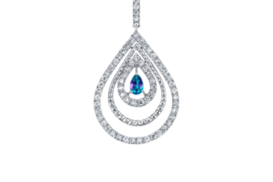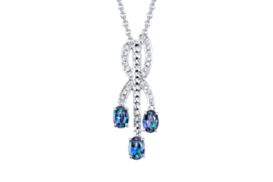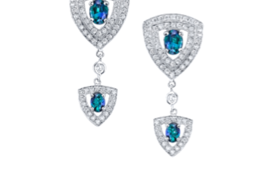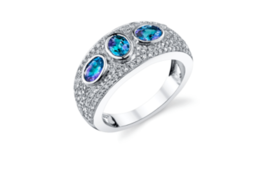THE ULTIMATE GUIDE TO REAL ALEXANDRITES
Table of Contents
- Alexandrite - The Rarest Gemstone?
- The True History of Alexandrites
- The Whitney Alexandrite
- Russia’s Controversial Alexandrite History
- The Discovery of The First Russian Alexandrite
- Who Coined The Name ‘Alexandrite’?
- Alexandrite Auction History
- The Alexandrite Effect
- Alexandrite Origins
- Alexandrites from Madagascar
- Alexandrites from India
- Alexandrites from Sri Lanka
- Alexandrites from Russia
- Alexandrites from Tanzania
- Alexandrites from Brazil
- Alexandrite Cat’s Eye
- Classifying Alexandrites
- Ideal Lighting Conditions To Witness Alexandrite’s Color Change
- Gem Labs (Certificates)
- What Makes A Stone Rare?
- New Collectors
Real Alexandrite - The Rarest Gemstone?
What is a Real Alexandrite?
Alexandrite, a color-changing variety of the mineral Chrysoberyl, is considered one of the rarest gemstones in the world. Gem aficionados often use the phrase ‘emerald by day, ruby by night’ for this beautiful gem. Why so? This is because the real alexandrite stone exhibits dual colors- a vivid grass green in daylight and an intense raspberry red at night.
The alexandrite birthstone is specifically meant for all those born in June. Hence its taken the name June Birthstone. Additionally, it is also the 55th wedding anniversary gift. While the alexandrite gem is very rarely available, we have these in stock for you. One thing that must be kept in mind while purchasing this stone is that the more apparent the color change, the better is the quality. When this is the case, the alexandrite price tends to be higher.
Considered to be one of the most cherished gemstones, the real alexandrite stone can be found across the world in today’s times. We will delve into its origins and history in a short while. Let us first look at some of the available lab definitions of the alexandrite gem.
Alexandrite Stone: Lab Definitions
American Gemological Laboratories (AGL): An Alexandrite stone is a Chrysoberyl where the dominant hue distinctly changes under different lighting conditions.

Swiss Gemological Institute (SSEF): Alexandrite is a variety of chrysoberyl with a definite colour change due to the presence of chromium traces. The different colours appear due to the light source under which the stone is observed. The effect depends on the amount and distribution of colour-giving trace elements. The two colours are usually blue-green in daylight and purplish-red in incandenscent light.

Gemological Institute of America (GIA): Any color change (not shift) makes Chrysoberyl into Alexandrite stone.

GemResearch SwissLab (GRS): Alexandrite stone is a chromium-bearing color-changing Chrysoberyl.

Gübelin Gem Lab (GUB): An Alexandrite stone is a variety of gem Chrysoberyl, which changes its main hue from daylight to incandescent light.

The True History of Alexandrites
Much like other birthstones, the alexandrite stone was discovered only in the 19th century, before which it was utterly unknown to the world. It was the auspicious event of Prince Alexander II’s birthday when this precious stone was first discovered in the emerald mines near the Tokovaya River in Russia’s Ural mountains in 1830.

Alexander II. Emperor of the Russian Empire 1855 until his assassination in 1881.
The story of the origins of alexandrite goes something like this: Russian miners were working on the Ural mountains in search of emeralds. One miner collected a few emeralds and took them back to the camp at night. When the miners saw the stone in the light of the campfire, they were shocked as the stone shone a brilliant shade of red which was not the color of emeralds.
While this is a local story, the official credit for discovering the Russian alexandrite goes to a person called Yakov Vasilevich Kokovin or Y.A. Kokovin. He was the Ural Mountain Mine Manager in the 1800s, and it is only through a single publication by the historian Richard A. Wise that we get to know about the history of alexandrite.
It was because the stone’s sometimes red and sometimes green colors resembled the Old Imperial Russia military colors that the alexandrite was declared to be the national stone in Tsarist Russia. The stone went on to become one of the most valued gems and a matter of great showoff among the Russian aristocracy. Gradually it was believed that the stone was becoming extinct.
Fortunately, expeditions and searches stumbled upon larger deposits of the alexandrite stone in Ceylon, now in Sri Lanka, and later in Brazil.
The Whitney Alexandrite
The Whitney alexandrite gets its name from Coralyn Wright Whitney, who gifted this gem to the National Gem Collection. Found in the Hematite Mine in Minas Gerais, Brazil, the Whitney alexandrite is one of the finest contributions of Brazil. It changes color under the impact of different lights, much like any other alexandrite.
An image of the stone can leave anybody spellbound. One color is raspberry red which can be seen during the night, and the other color is teal or green-blue, which can be seen during the day. The unique light-changing characteristic of alexandrites, including the fine quality Brazilian alexandrite called Whitney alexandrite, is also known as “the alexandrite effect.”
The reality, however, is that the dramatic color shift that you may read about in a lot of articles and blogs is actually not true most of the time. Only the rarest and the best quality alexandrites will exhibit this quality, while in a majority of the stones, the color change is almost non-existent.
The Whitney alexandrite stone can be found at the Smithsonian Museum of Natural History. This stone weighs approximately 17.08 carats, but its estimated value is unknown.

Russia’s Controversial Alexandrite History
There is a widely popular but controversial story regarding the history of this enigmatic gemstone- the alexandrite. Scientific publications regarding the stone and its official name as alexandrite were carried out by a Finnish mineralogist Nils Gustaf Nordenskjold in 1842. However, the stone was actually discovered much before by workers at a mine in the Ural mountains.

Nils Gustaf Nordenskjold
In 1831, after Kokovin opened the famous Emerald Pits on the river Tokovaya, a local peasant charcoal-burner named Maxim Stefanovich Kogevnikov came across a cluster of beautiful green emeralds, which was later on discovered to change color at night. Despite such discovery under the supervision of Kokovin, it is still unclear to date why he was relieved of his duties soon after the incident.
Historical evidence also shows that Kokovin was briefly imprisoned, and all of this disgrace and dishonor led to his poor health. The reasons remain unknown. Controversy also exists in terms of the apparent animosity between Kokovin and yet another name associated with the stone- Count L.A. Perovskii. To read more download our Free Alexandrite Ebook.
The Discovery of The First Russian Alexandrite
The Russian Imperial Mineralogical Society was established in 1817, and the discovery of the first Russian alexandrite has been traced back to this establishment. However, there is still an abundance of uncertainties and secrecy associated with the actual discovery. The Gemological Institute of America (GIA) has officially stated that the Russian Alexandrite was first discovered in 1830 by a group of miners in the Ural mountains.
However, even an institution of such great eminence and popularity like the GIA has refrained from going into the details of the discovery or coming up with a single name of the person who chanced upon it. This ambiguity says a lot about the nature of the discovery and the probable politics attached to it.
While narrowing down the real individual behind the discovery of the Russian alexandrite has been challenging, there was yet another matter that complicated the entire scenario. This was that Chrysoberyl (the mineral from which alexandrite hails) had already been discovered long before 1830. The question then arises that whoever distinguished chrysoberyl from beryl or emerald due to the noticeable color change must have been someone with a good deal of mineral knowledge.
Who can we attribute the eureka moment to? Who was the individual that realized this was a new variety of stone and coined its name? These questions remain in the minds of gem and jewelry enthusiasts. Due to these nuanced circumstances, pinning the discovery of the natural alexandrite becomes difficult.
There are too many people involved and yet not a specific person to be named. Therefore, the answer to the question depends on who attributes what as discovery. Some may say the regular miner is the one, while others say a knowledgeable mineral expert is the one.
Who Coined The Name ‘Alexandrite’?
The name for this is widely and popularly known to be the Finnish mineralogist- Nils Gustaf Nordenskjold. Various sources and records credit him with the discovery of the first samples of the Russian alexandrite. Gustaf named it alexandrite as a form of tribute to the future Tsar on the occasion of his birthday celebration in the Ural mountains, where the stone was discovered.
Gustaf’s family archive and other historical documents are reviewed over the course of the book ‘Russian Alexandrites.’ Along with the archives, several letters and correspondence written by him were also scrutinized. However, the word “Alexandrite” was never mentioned in those letters before 1842. However, we cannot tell if this was because Gustaf was not the one who coined the name or because the government censored a great deal of information in these letters.
Alexandrite Auction History
Let us look at the highest alexandrite costs and alexandrite price per carat through the auction history of this precious gem. At the Magnificent Jewels New York Auction, one of the most expensive alexandrites from Sri Lanka was sold at a whopping $557,000.00. It would be just over $30,000 per carat at $18.23 carats. The American Gemological Laboratories attested the stone by writing about the significance and prestige attached to this genuine alexandrite stone.
Over the years, the Christie’s Auction earned massive fame as it became the site of selling some of the largest known alexandrite stones. In October 2007, one of the largest alexandrites from Brazil was sold in the Magnificent Jewels Auction at 19.05 carats. The alexandrite and diamond ring sold for a huge sum of $959,400. That amounts to more than $50k per carat.

A few years later, in 2014, yet another large 21-carat Russian alexandrite was auctioned at Christie’s held in the Geneva Magnificent Jewels, Switzerland. After much bidding, the stone was sold at $60,000 per carat. Then again, in 2015, a 26-carat Ceylon alexandrite was auctioned by Sotheby’s in Magnificent Jewels, New York. The final price stood at $754,000.00.

Over the years, there have been many natural alexandrite gemstones that have come from Brazil and other places across the world. An alexandrite and diamond ring was auctioned at the Hong Kong Magnificent Jewel Auction at a whopping $931,000 or just under $60,000 per carat. In 2017, a 9.99-carat Brazilian alexandrite sold for $313,000.00.

The Alexandrite Effect
The color change that alexandrites are so popular for is only visible in the most genuine alexandrites, and there are ways to test this. Follow these steps to know more:
Step 1: How to check the primary color under daylight?
- Bring the stone under daylight or fluorescent desk light.
- Depending on the gemstone quality, you will see variations in color.
- The colors seen will be all shades of green such as bluish-green, yellowish-green, brownish-green, etc.
Step 2: How to check for a color change?
- For this, you need some kind of incandescent light like warm yellow light. Candlelight or penlight will work the best, and it is preferable if the surrounding environment is completely dark.
- Once again, depending on the quality of the alexandrite, you will witness the color changing to shades of purple such as reddish-purple, pinkish purple, brownish-purple.
While this is something you can try out, it is always better to leave the main work to experts. Ensure that the natural alexandrite you are purchasing is accompanied by a reputable lab report that will guarantee authenticity and provide you with a clear description of the color change, if any.
Alexandrite Origins
Tracing the true origins of alexandrites is something best left to the labs to determine. Imitation alexandrites have been sold in the market for over 100 years. It can be fairly challenging to distinguish the lab-created or synthetic alexandrites without the assistance of proper equipment, which people devoid of expert knowledge are unlikely to possess. The color of an alexandrite alone can be beneficial in tracing the origins of the precious stone. It’s helpful in predominantly two different ways- 1) it helps to figure out where the stone is from, and 2) it helps to figure out where the stone is not from.
Alexandrites from Madagascar
It is a common misconception among people and sometimes even jewelry enthusiasts that alexandrites from Madagascar have a darker or browner tone. This presumption oversees the fact that some of the finest alexandrites produced in the market today are originally from Madagascar. These tend to have a blue-green color under daylight.
The lower quality alexandrites, which are also found in plenty, tend to have the dominant brown colors. Often, the stone with a muddy green color under daylight will show a brown modifier shade when held under incandescent light. However, the way to confirm that the alexandrite gemstone is of superior quality is when the green shade is overpowering than any other shade when kept under daylight.
You will know that it is of even better quality when the green shade also has a bluish tinge. On the other hand, the purple shade will also have a pink-purple intensity of color, and this is a true competition to the alexandrites found in the rest of the world. Ensure that the alexandrites you purchase are from a reputable source or carries a reputable gem lab report. On our website, you will find that alexandrites over 1ct possess a GIA report and all our pieces carry a proof of authenticity. Since we buy our alexandrites directly from the Hematita mine in Brazil and manufacture our own jewelry, we can guarantee the authenticity of the stones we use.
3.55ct top quality natural alexandrite from Madagascar. High quality Madagascar and Tanzanian material can resemble Brazlian Alexandrites but are extremely rare. The majority of the stones appear brownish with a muddy color change.

Alexandrites from India
Among the most superior-quality alexandrites found in the world, those originating from India are some great stones. These have a distinct pure green appearance when seen in daylight. Through many of our gemstone mining connections in India, we have found that the alexandrites coming from Orissa are smaller in size than usual (<0.5 cts).
The emerald color during the daytime is usually a rich grassy green hue. However, the purple seen under incandescent light is not as dramatic as is the case in alexandrites found in other parts of the world. It can be described ranging from medium to light in its saturation.
While the production of alexandrites is relatively limited in India, the best quality ones range from hues of occasional blue-green to rich purple.

Alexandrites from Sri Lanka
Earlier known as Ceylon, the exotic country of Sri Lanka is commonly referred to as the “Island of Gems.” The shade of these alexandrites is slightly different from the shades found in Madagascar or India. The Sri Lankan alexandrite is yellowish-green in appearance when seen in daylight. These stones are also larger in size than the alexandrites found elsewhere. The larger size, however, does not mean a more dramatic color change.
The few Sri Lankan alexandrites that boast dramatic color change remain extraordinarily scarce. These are usually not found to be sold in commercial markets and those that are, are exorbitantly priced. Trying to figure out the difference between alexandrites from Madagascar and Sri Lanka has proved to be extremely difficult.
What happens, in reality, is that the local suppliers in Sri Lanka source the natural and rough alexandrites from Madagascar and cut the material here. Once these are polished, it is a challenging task to trace the source of the gemstone. Ultimately, labs have the knowledge, training, and equipment to determine the origin of any alexandrite gemstone.

Alexandrites from Russia
The history of alexandrites has always been traced back to their discovery in the Ural mountains in Russia before any other part of the world. It has become increasingly difficult to find a superior-quality alexandrite stone of more than 1 carat in Russia today. The authentic stone that we get from Russia is usually emerald and whatever alexandrite is found today is of inferior quality.
As already mentioned in the initial part of this article, the alexandrite from Russia is known by a popular phrase- “emerald by day, ruby by night.” These mostly refer to the few Russian alexandrites that have exhibited dramatic color change. Unfortunately, these are scarce in number. The alexandrites with blue-green colors can often be confused with any other source, making tracing its authenticity a big problem.
An old cutting or faceting might hint towards some kind of original identification. However, our suggestion is to rely more on lab reports rather than on a judgment of the eye.

Alexandrites from Tanzania
The nature of Tanzanian alexandrites remains elusive as experts often confuse them with those originating from Brazil and Madagascar. This is because of the similarity in the characteristics between all of these. When held under daylight, the alexandrites from Tanzania display a light Mediterranean bluish-green color. As per our experience, they exhibit a dramatic color change in incandescent light.
Most of the alexandrites found in Tanzania come from Lake Manyara in the north and Tunduru in the south. On our recent trip to the country, we were unsuccessful in finding any alexandrites, and this is testimony to the rarity of any original Tanzanian alexandrites.

Alexandrites from Brazil
Alexandrites in Brazil can be traced back to many years ago when in the early 1980s, a significant mine containing precious gemstones was discovered. This was popularly known as the “Hematite” mine, and its discovery attracted a substantial number of miners to the area. Some other sites are known for mining alexandrites (but of lower quality) are Bahia and Espirito Santo.
For about 12 weeks, this rush lasted when miners came from faraway places in the hope of digging out the color-changing alexandrites. Let us look at the characteristics of the Brazilian alexandrites now. They exhibit a rich bluish-green hue under daylight, which transforms into an intense purple under incandescent light. The specific hue of the Brazilian alexandrite is unique, and it is easily distinguishable from alexandrites found elsewhere.
However, much like the case of Russia, alexandrites over 1 carat are scarcely found in Brazil. They are nearly extinct.
It is commonly known that the desire to own a particular gemstone usually stems from where that gemstone was discovered—for example, blue sapphires from Kashmir, rubies from Burma, and Paraiba Tourmalines from Brazil. One will say the same for the alexandrites from Russia. However, the most precious and authentic alexandrites no longer come from Russia- they come from Brazil.
While plenty of folktales will tell you about the green to the red color change of the Russian alexandrites, its Brazilian counterpart exhibits a more impressive bluish-green color under daylight which can be seen to magically change to a deep rich purple under the incandescent light. The rich history of the Russian alexandrites has overshadowed the actual king of the game in the present times- the Brazilian alexandrite.
A good-quality carat-size alexandrite hailing from Brazil exceeds the diamond carat-size equivalent. However, genuine alexandrites have become scarce over the years and what we have today is mostly a lab-created version of it. While it is recommended that you get a lab test done to know about the origins of the alexandrite, the labs will charge you extra for this. However, this additional fee is worth it when you find out the truth behind claims by sellers that the real alexandrite is from Russia or Brazil.

Alexandrite Cat’s Eye
This is a double phenomenon stone that changes color and has “chatoyancy” which provides a cat’s eye effect. It’s extremely rare and expensive and although Safiya Alexandrites do not have any alexandrite cat’s eye designs on display, we have had them in the past so please contact us for help sourcing one.

Classifying Alexandrites
It is a far too restrictive statement when certain experts or jeweler enthusiasts claim that alexandrite is a kind of chrysoberyl that changes from green to red. A more apt description would be to classify them as possessing a greenish hue in fluorescent light and a reddish hue under incandescent light. The actual colors, however, have a far more expansive range. Some common examples of the colors displayed by alexandrites include:
- Green to purplish-pink
- Bluish-green to purple
- Green-blue to purplish-red
- Green to grayish purple
- Yellowish-green to brownish-purple
Dr. Malsy is a gemstone expert who has written extensively on colored gemstones and has even published a well-researched article on distinguishing between genuine alexandrites and synthetic ones. She writes how she has never seen a purely red alexandrite but only varying shades, including purple, reddish-purple, or purplish-red.
Ideal Lighting Conditions To Witness Alexandrite’s Color Change
You can witness an alexandrite’s color change in two ideal conditions. The shade of green can be seen in natural/daylight corresponding to a range between 5500K to 6500K. To view the second color change, you need a yellow, warm light ranging between 2700K to 3600K.
Gem Labs (Certificates)
What is a gem lab?
A gemological lab is an institution or organization that, after conducting tests, generates reports on loose gemstones and mounted jewelry. Lab reports will provide you with the following details:
- Weight (in carats)
- Description of the shape
- Measurements
- Color description
- Treatment (if needed)
- Variety of gem
- A photograph of the gemstone
- With an additional fee, the origin of the gemstone
These lab reports are known as “certificates” in the gemstone business. You must always keep your mind open even when a scientific laboratory provides the results as these too are liable to make mistakes.
What are some of the reputable gem labs?
Every gemstone must have the backing of at least one reputable independent lab. As per our personal opinion, the American Gemological Laboratories are the most trustworthy labs for any gemstone collector. Here is a list of some of the most reputed and responsible gem labs:
- GRS Gem Research Lab (Hong Kong)
- SSEF Swiss Gemological Institute (Switzerland)
- AGL American Gemological Laboratory (USA)
- GIA Laboratory (USA)
- Gubelin Gem Lab Ltd (Switzerland)
What Makes A Stone Rare?
Two factors determine the rarity of a gemstone- availability and market desirability. An informed collector will be aware of the following:
- Proper marketing can influence and coax a person into wanting anything.
- The true value of a jewel does not merely lie in its outer beauty and how fashionable it is.
- If a gemstone is ugly, it will hardly be desirable in a commercial market. Even if it is the rarest of the rare stones
Here are some characteristics that make a stone rare:
- Treatment- This simply means whether the stone is treated or untreated. What needs to be found is whether the stone came naturally from the ground or through a foreign process. If the stone is natural, it is considered to be rare.
- Size- The bigger the size, the more unique or rare the stone is.
- Origin- Gemstones from exotic parts of the world are considered to be more rare and difficult to access.
- Clarity- Clean-looking gems without blemishes and interior obscurities are rarer than the rest.
- Cutting- If the stones are cut to maximize light reflection, then it is considered rare.
- Shape- Peculiar shapes tend to make a stone more rare and even desirable.
There is a quick formula to figure out the rare stones- low availability and high market desirability.
New Collectors
At Safiya Alexandrites, our goal is to bring significant recognition to the alexandrite gemstone and the fact that it is one of the rarest gemstones in the world. Many are aware of the significance already and dream of owning an alexandrite someday. We are here to fulfill those dreams by bringing to you natural alexandrites. Every piece of jewelry is backed by a certificate of authenticity and stones that are larger than 1ct carry one of the reputed lab reports mentioned previously.
Why Us?
It was many years ago, at the world-famous Tucson Gem show that our founder was inspired by some Brazilian alexandrites and decided to show their true value to the world. We fell in love with the stone and started specializing in the late 1990s as a result. Alexandrites stones were introduced to Japan and we became one of the biggest buyers of the precious stones and have been collecting ever since.

Claims of rarity when it comes to gemstones flood the internet. While some are genuine, others are fraudulent, and the only way you can ensure not being conned is by doing as much research on whichever gemstone you wish to purchase. We have traveled far and wide to explore the different kinds of gemstones available. Thus, we can confidently say that we are experienced when it comes to alexandrites.
We always keep our customers updated regarding all our recent findings of gemstones. A fully informed-educated disclosure is our philosophy. Another reason to choose us is that we rely on independent third-party labs that are reputed and trustworthy.
We pledge to serve you with the best alexandrites.
Why Safiya Alexandrites over other alexandrites?
There are very few gemstones in the world that are so rare and yet so collectible. While every alexandrite has a unique color change to offer, we believe that the Safiya Alexandrites are truly one-of-a-kind. Every year we craft a very limited number of natural alexandrite jewelry that we release in the market. We stand by our product and we offer a 14-day hassle-free RETURN POLICY so if you’re unhappy with your purchase, we’ll cover the cost of shipping and provide a full refund so there’s zero risk for you. You’d be eligible for a LIFETIME GUARANTEE on workmanship because your satisfaction is important to us. We have a fantastic UPGRADE POLICY so you can invest in a piece that serves you today and upgrade to something greater in the future - a unique piece of jewelry as you evolve.

